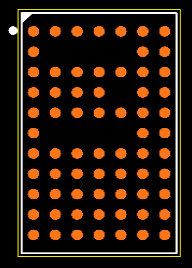5M80ZM68C4N CPLDs: Features, Applications and Datasheet
2025-03-05 15:06:08 618
5M80ZM68C4N Description
A component of the Altera (now Intel) MAX V CPLD series, the 5M80ZM68C4N is made for high-density, low-power logic applications. This device comes in a 68-pin QFP (M68) packaging and has 80 logic elements (LEs). It maintains quick performance and adaptable I/O capabilities while being tuned for power-efficient designs.
5M80ZM68C4N Features
Low Power Consumption: The MAX V series offers the industry's lowest static power consumption among CPLDs, making it suitable for battery-powered devices.
High Integration: Up to 80 LEs and embedded user flash memory.
Non-Volatile Architecture: Configuration is stored in on-chip flash memory, ensuring immediate startup after power-on.
Fast Timing Performance: Supports low propagation delays, making it ideal for timing-critical applications.
Multiple I/O Standards Support: Compatible with 3.3V, 2.5V, and 1.8V I/O logic levels.
JTAG Boundary Scan: Built-in JTAG interface for easy debugging and in-system programming (ISP).
Integrated Oscillator: Reduces external component requirements.
5M80ZM68C4N Applications
The 5M80ZM68C4N is widely used in applications where small, power-efficient logic is needed:
Embedded Systems (low-power controllers and state machines)
Consumer Electronics (portable devices, smart gadgets)
Industrial Automation (programmable logic controllers, sensor interfacing)
Communication Equipment (protocol bridging, glue logic for custom interfaces)
Automotive Electronics (basic logic functions in infotainment and diagnostics)
5M80ZM68C4N CAD Model
Footprint

5M80ZM68C4N Alternative
If you are looking for alternatives due to pricing, availability, or feature requirements, consider:
5M160ZM68C4N – A higher logic capacity CPLD with 160 LEs in the same MAX V family.
XC2C128-7VQ100C (Xilinx CoolRunner-II) – Offers low power consumption and a similar logic density.
ATF1508ASV-15AU100 (Microchip) – A high-performance CPLD with similar I/O flexibility.
5M80ZM68C4N Other Information
Programming Cycles: The on-chip flash memory is rated for at least 10,000 erase/write cycles, making it reliable for long-term applications.
Configuration Time: The device configures instantly upon power-up, typically in less than 1 ms.
I/O Pin Drive Strength: Each I/O pin can be configured for 4 mA or 8 mA drive strength, allowing flexibility for interfacing with different loads.
Latch-Up Immunity: The device is designed to withstand transient voltage spikes, reducing the risk of accidental logic state corruption.
Internal Power Rail Management: Built-in voltage regulators provide better power stability in applications with fluctuating supply voltages.
5M80ZM68C4N Manufacturer
Intel Corporation is a global leader in semiconductor innovation, shaping the future of computing with advanced processors, AI accelerators, and cutting-edge manufacturing technologies. Founded in 1968, Intel pioneered the microprocessor revolution, fueling the growth of personal computing, data centers, and embedded systems. Today, it drives breakthroughs in high-performance computing, AI, and autonomous systems, leveraging its x86 architecture alongside emerging chiplet and hybrid computing designs.
With its IDM 2.0 strategy, Intel is revitalizing semiconductor manufacturing, investing heavily in leading-edge fabs across the U.S. and Europe. The company’s roadmap includes innovations like Intel 3, Intel 20A, and RibbonFET transistors, pushing performance and efficiency to new levels. Beyond silicon, Intel powers cloud, networking, and edge AI, fostering open ecosystems through initiatives like oneAPI.
As a key player in global supply chain resilience and AI-driven workloads, Intel continues to redefine computing’s role in business, research, and everyday life. From data centers to autonomous vehicles, Intel’s relentless innovation fuels a smarter, more connected world.
5M80ZM68C4N FAQs
Question: Can the 5M80ZM68C4N operate reliably in high-vibration environments?
Answer: Yes, the MAX V series CPLDs are designed with solid-state, non-volatile flash storage, which makes them highly resistant to mechanical shocks and vibrations. However, careful PCB layout is required to prevent electrical noise from affecting timing-sensitive signals.
Question: How does the power-up sequence of the 5M80ZM68C4N affect system performance?
Answer: This CPLD supports an instant-on feature due to its flash-based storage. Unlike SRAM-based FPGAs, there’s no need for an external configuration device, which significantly reduces boot time and allows predictable system initialization.
Question: What are the design considerations for reducing EMI when using this CPLD?
Answer: To minimize electromagnetic interference (EMI), use shorter trace lengths, proper ground planes, and series termination resistors on high-speed I/O lines. Additionally, configuring unused pins as outputs and driving them low can help reduce noise.
Question: Can this CPLD handle clock domain crossings effectively?
Answer: While the MAX V series CPLDs support multiple clock inputs, designers should implement double-register synchronization techniques or FIFO buffering to handle clock domain crossings safely and avoid metastability issues.
Question: How does ambient temperature affect timing performance in this device?
Answer: The C4 speed grade of this CPLD ensures operation up to 85°C commercial temperature range, but propagation delays can slightly increase with rising temperatures. For extreme conditions, careful timing analysis and signal margin adjustments are recommended.




